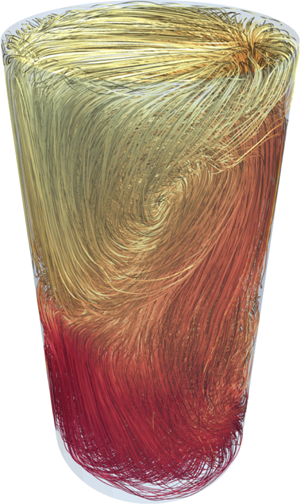Crossref Citations
This article has been cited by the following publications. This list is generated based on data provided by
Crossref.
Urban, P.
Králík, T.
Macek, M.
Hanzelka, P.
Věžník, T.
and
Skrbek, L.
2021.
Effect of boundary conditions in turbulent thermal convection
(a)
.
EPL (Europhysics Letters),
Vol. 134,
Issue. 3,
p.
34003.
Samuel, Roshan
Samtaney, Ravi
and
Verma, Mahendra K.
2022.
Large-eddy simulation of Rayleigh–Bénard convection at extreme Rayleigh numbers.
Physics of Fluids,
Vol. 34,
Issue. 7,
Vieweg, Philipp P.
Scheel, Janet D.
Stepanov, Rodion
and
Schumacher, Jörg
2022.
Inverse cascades of kinetic energy and thermal variance in three-dimensional horizontally extended turbulent convection.
Physical Review Research,
Vol. 4,
Issue. 4,
Käufer, Theo
Vieweg, Philipp P.
Schumacher, Jörg
and
Cierpka, Christian
2023.
Thermal boundary condition studies in large aspect ratio Rayleigh–Bénard convection.
European Journal of Mechanics - B/Fluids,
Vol. 101,
Issue. ,
p.
283.
Zhang, Yu
Jiang, Hao-Kui
Luo, Kang
Li, Tian-Fu
Wu, Jian
and
Yi, Hong-Liang
2023.
Electro-thermo-convection in a high Prandtl number fluid: Flow transition and heat transfer.
International Journal of Heat and Mass Transfer,
Vol. 201,
Issue. ,
p.
123630.
Krasnov, Dmitry
Akhtari, Ali
Zikanov, Oleg
and
Schumacher, Jörg
2023.
Tensor-product-Thomas elliptic solver for liquid-metal magnetohydrodynamics.
Journal of Computational Physics,
Vol. 474,
Issue. ,
p.
111784.
Wondrak, Thomas
Sieger, Max
Mitra, Rahul
Schindler, Felix
Stefani, Frank
Vogt, Tobias
and
Eckert, Sven
2023.
Three-dimensional flow structures in turbulent Rayleigh–Bénard convection at low Prandtl number Pr = 0.03.
Journal of Fluid Mechanics,
Vol. 974,
Issue. ,
Xiao, Mingfei
Ren, Yangjian
Yang, Junjiao
and
Hu, Zhan-Chao
2024.
Turbulent Rayleigh–Bénard convection in a supercritical CO2-based binary mixture with cross-diffusion effects.
International Journal of Heat and Mass Transfer,
Vol. 228,
Issue. ,
p.
125648.
Zhang, Yu
Chen, Di-Lin
Luo, Xiao-Ping
Luo, Kang
Wu, Jian
and
Yi, Hong-Liang
2024.
Coulomb-driven electroconvection turbulence in two-dimensional cavity.
Journal of Fluid Mechanics,
Vol. 980,
Issue. ,
Creyssels, Mathieu
and
Martinand, Denis
2024.
Stability analysis of sheared thermal boundary layers and its implication for modelling turbulent Rayleigh–Bénard convection.
European Journal of Mechanics - B/Fluids,
Vol. 105,
Issue. ,
p.
97.
Tripathi, Vinit Kumar
Mahajan, Amit
and
Dubey, Rashmi
2024.
Effect of variable viscosity, porous walls and mixed thermal boundary condition on the onset of Rayleigh-Bénard convective instability.
European Journal of Mechanics - B/Fluids,
Vol. 104,
Issue. ,
p.
102.
Zhang, Yu
Luo, Kang
Yi, Hongliang
Liu, Anjun
and
Wu, Jian
2024.
Application of large eddy simulation models to electroconvection turbulence study with lattice Boltzmann method.
Physical Review Fluids,
Vol. 9,
Issue. 8,
Vieweg, Philipp P.
2024.
Supergranule aggregation: a Prandtl number-independent feature of constant heat flux-driven convection flows.
Journal of Fluid Mechanics,
Vol. 980,
Issue. ,
Vieweg, Philipp P.
Käufer, Theo
Cierpka, Christian
and
Schumacher, Jörg
2025.
Digital twin of a large-aspect-ratio Rayleigh–Bénard experiment: role of thermal boundary conditions, measurement errors and uncertainties.
Flow,
Vol. 5,
Issue. ,

 $\varGamma =1/2$ in air for a Prandtl number
$\varGamma =1/2$ in air for a Prandtl number  $Pr=0.7$ and a Rayleigh number
$Pr=0.7$ and a Rayleigh number  $Ra=10^7$ and in the liquid metal alloy GaInSn at
$Ra=10^7$ and in the liquid metal alloy GaInSn at  $Pr=0.033$ and
$Pr=0.033$ and  $Ra=10^7$,
$Ra=10^7$,  $10^8$. We apply for each case three different thermal boundary conditions at the top and bottom of the fluid volume while leaving the solid sidewall thermally insulated: (i) fixed temperature, (ii) fixed heat flux and (iii) conjugate heat transfer which couples the temperature and heat flux in the working fluid to that of the finitely thick, solid plates enclosing the turbulent flow. The global heat transfer is enhanced by up to 19 % for the conjugate heat transfer case in comparison to that of isothermal plates. The differences decrease for the lower of the two Prandtl numbers; they remain generally smaller for the global turbulent momentum transfer. Mean temperature profiles and root mean square velocity fluctuations are surprisingly weakly affected. The largest difference appears for the distribution of local thermal boundary scales when the cases of fixed temperature and of conjugate heat transfer are compared. We also discuss our results in view to experimental uncertainties in liquid metal experiments.
$10^8$. We apply for each case three different thermal boundary conditions at the top and bottom of the fluid volume while leaving the solid sidewall thermally insulated: (i) fixed temperature, (ii) fixed heat flux and (iii) conjugate heat transfer which couples the temperature and heat flux in the working fluid to that of the finitely thick, solid plates enclosing the turbulent flow. The global heat transfer is enhanced by up to 19 % for the conjugate heat transfer case in comparison to that of isothermal plates. The differences decrease for the lower of the two Prandtl numbers; they remain generally smaller for the global turbulent momentum transfer. Mean temperature profiles and root mean square velocity fluctuations are surprisingly weakly affected. The largest difference appears for the distribution of local thermal boundary scales when the cases of fixed temperature and of conjugate heat transfer are compared. We also discuss our results in view to experimental uncertainties in liquid metal experiments.